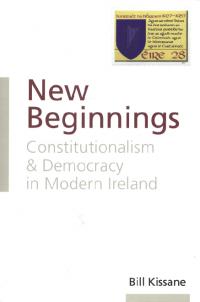New beginnings: constitutionalism and democracy in modern Ireland
Published in 20th-century / Contemporary History, General, Issue 2 (March/April 2013), Reviews, Volume 21
New beginnings: constitutionalism and democracy in modern Ireland
Bill Kissane
(University College Dublin Press, €28)
ISBN 9781906359515
Bill Kissane has long established himself as an innovative authority on modern Irish political and constitutional history. (As he points out, the two are not necessarily the same.) Nobody reading his nuanced The politics of the Irish Civil War will ever again view that conflict, pace Tom Garvin, as a Manichean struggle between small-d democrats and romantic authoritarian ideologues. And his Explaining Irish democracy plausibly accounts for Ireland’s emergence as a stable democratic polity, after and despite its civil war, at a time when other democratic experiments were foundering.
His latest book, New beginnings, is even more ambitious than its predecessors, for it encompasses the entire period of Irish independence. It focuses on what Kissane calls five actual or potential ‘constitutional moments’, when Irish élites or the Irish people as a whole pondered fundamental questions about governance. Kissane’s five watersheds are the 1919 Dáil constitution, a bare-bones document of but a single page; the 1922 Free State constitution, which was constrained by the Anglo-Irish Treaty; the 1937 constitution, which burst those constraints to create a virtual if not yet complete republic; the social upheavals that began in the late 1960s, fracturing the pre-existing consensus (Catholic, nationalist) and producing a series of constitutional referendums; and the 1998 Belfast Agreement, which bridged the sectarian divide and revived prospects for a unified island. Unsurprisingly, the 1937 constitution, by its sheer endurance, commands the most attention.
The Irish context alone makes the book worth reading. Make no mistake: the 1937 constitution was initially a partisan instrument, the handiwork of the then-dominant Fianna Fáil party and its leader, Eamon de Valera. The other major parties either opposed it or were neutral; a plebiscite barely adopted it. Yet it has become, like its American counterpart, iconic: a symbol, and thereby an enabler, of national unity. Kissane aptly explains why: its amendment process has proved flexible enough to accommodate social and political changes, its checks and balances well-calibrated enough to reconcile majority rule with judicially enforceable restraints, its framework tough enough, and its symbolism compelling enough, to survive economic collapse. In common with the Greek philosophers’ Ship of Theseus, it has remained fundamentally the same even as its planks—the claim to all-island sovereignty; the Catholic Church’s ‘special position’; the divorce ban—have been incrementally replaced. For this, Kissane gives de Valera credit, noting his decisive role in its drafting and his (mostly) principled use of its powers while in office. (And indeed Dev’s thinking matured since his Civil War days, when he threatened to ‘wade through Irish blood’ and declaimed that ‘the majority has no right to do wrong’.) By thus rehabilitating him, Kissane aligns himself with other recent commentators: Diarmaid Ferriter, in Judging Dev; Gerard Hogan, whose The origins of the Irish constitution, 1928–1941 is as ground-breaking as New beginnings. Like the Civil War itself, the man’s character was more nuanced than some authors (Tim Pat Coogan?) acknowledge.
But if the context is Irish, the themes are universal, and Kissane develops them brilliantly. Should constitutions strike out in fresh directions, as suggested by the book’s title? Should they be evolutionary adaptations—in Ireland’s case, of the hated coloniser’s Westminster model, with its powerful, centralised, cabinet system? Or should they hearken back to some real or imagined past—which, again to take Ireland’s case, meant a Gaelic, Catholic past with a putative tradition of local autonomy that was the antithesis of Westminster’s? What the Irish wound up with, in 1919, 1922 and 1937 alike, was the Westminster model—tempered, in the latter two instances, by judicially enforceable restrictions on power, some liberal in origin, others (in the 1937 constitution only) Catholic. So ascendant, though, was the Westminster model, especially in the decades before Irish judges discovered American-style judicial activism, that one wonders whether the title is ironic, or should at least have a question mark at the end.
There is a second theme, of equal import: should constitutions be minimalist instruments, establishing necessary governing institutions and no more, or should they be what Kissane calls ‘manifestos’, incorporating cherished values? (The ’37 constitution contains elements of both.) The question is of no great moment when the values are nigh-universal—say, Irish Catholic values in the 1930s—but becomes weightier when they are in disarray, as in today’s increasingly secular Ireland or increasingly religious America. The polarising impact of the US Supreme Court’s abortion decision, Roe v. Wade, underscores how the manifesto approach can destabilise a divided nation by blurring Kissane’s ‘distinction between ordinary and constitutional politics’ and impairing the constitution’s symbolic authority. There are benefits to the notion of a constitution as a Rorschach inkblot test, onto which contending factions can project their own values. Of course, the dichotomy between instrumentalism and the constitution-as-manifesto is not always clear: is free speech instrumental, facilitating democracy, or are both of these liberal values that are not universally shared? (The debate still roils the French.)
Irish judges are acutely aware of American constitutional developments; indeed, their late-found activism, to which Kissane alludes, often explicitly invokes US precedents. American judges seldom reciprocate their cosmopolitanism, and, when they do, are excoriated for betraying American exceptionalism. That’s a pity, for the two countries have much to teach one another, with each undergoing its own values crisis, across similar fault lines: religious fundamentalism versus secularism; insularity versus inclusiveness. And the Irish have made their own exceptionalist claims. Granting, arguendo, the exceptionalist premise, the question becomes: which America is exceptional? Which Ireland? HI
















